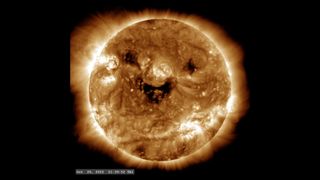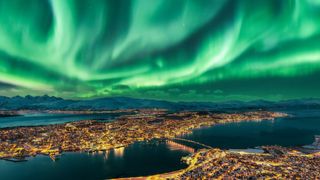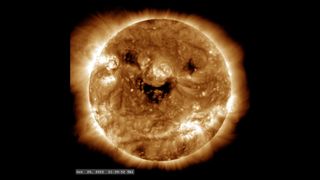There’s no doubt we’ve been treated to some remarkable aurora shows this year (the May superstorms and the recent strong activity in October spring to mind) but what if I told you this was only the beginning of some incredible northern lights activity?
In October 2024, scientists announced that the sun has reached solar maximum, a period of heightened solar activity and sunspot frequency that occurs during the sun‘s approximately 11-year solar cycle. During the solar maximum period, the sun emits more energized particles as it erupts with coronal mass ejections (CMEs) and solar flares, which can trigger geomagnetic storms and intensify aurora displays. Now that solar maximum is underway, it’s understandable that many declare THIS is the year for the northern lights. However, scientists believe the best aurora activity in this solar cycle is still to come.
Space.com spoke to solar physicist and northern lights expert Pål Brekke and solar and astrophysical researcher Scott McIntosh to learn more about when you can expect the highest auroral activity this solar cycle and how to make the very most of your aurora-hunting efforts. Spoiler alert: you may have more time than expected to plan your next trip to see the northern lights.
Pål Brekke is a Norwegian solar physicist and northern lights expert working as Lead of Space Science at the Norwegian Space Agency. Brekke has previously worked at NASA Goddard Space Flight Center as the Deputy Project Scientist for the sun-observing satellite SOHO and is the author of several books about the sun and the northern lights.
It’s good news for aurora chasers as peak auroral activity occurs a few years after solar maximum, according to Brekke. This means the best time to see the northern lights and the southern lights will be during the 2026-2027 aurora season.
You may like
But why?
The northern lights (aurora borealis) and the southern lights (aurora australis) are created when energized particles from the sun hit Earth’s atmosphere and are funneled toward the poles by our planet’s magnetic field. As the particles are redirected toward the poles, they interact with our atmosphere, by depositing energy, causing the atmosphere to fluoresce, or emit visible light. We have come to recognize this fluorescence as the northern and southern lights.
“As mentioned, the aurora activity varies with the solar cycle. However, the peak in the aurora activity (if you plot the Ap or Kp-index) comes a few years after solar maximum. Thus, we should have several years still with very high aurora activity.” Brekke explains.
For anyone familiar with aurora forecasting apps and software, the Kp-index is something you’ve likely come across.
“It is the global geomagnetic activity index based on 3-hour measurements from ground-based magnetometers around the world,” Brekke explains. Likewise, the Ap-index is a similar geomagnetic index driven by the sun’s magnetism and solar wind. Together, Kp and Ap are good proxies for aurora activity.
If you plot solar activity, indicated by the number of sunspots on the surface, and the Kp-index, there is a clear variation of aurora activity with the approximately 11-year solar cycle. But note that the peak in aurora activity actually occurs a few years after solar maximum. You can view an interactive graph of this activity here courtesy of GRZ German Research Centre for Geosciences.
“This means that 2026-2027 should be great for hunting the northern and southern lights” Brekke told Space.com.
But why this so-called “aurora lag”? Brekke explains one reason is that Earth-directed coronal holes are more frequent in the decaying phase and the solar minimum period.
Coronal holes are dark regions in the sun’s corona when viewed in extreme ultraviolet and soft X-ray solar images. Like sunspots, they appear darker because they are cooler than the surrounding plasma. Coronal holes are areas of open, unipolar magnetic fields (where the magnetic field predominantly has one polarity, either north or south) that allow solar wind to escape more easily into space, according to the National Oceanic and Atmospheric Administration Space Weather Prediction Center (NOAA SWPC).

When directed at Earth, the stream of solar wind flowing from a coronal hole can impact Earth’s magnetosphere, triggering geomagnetic storm conditions and resulting in impressive aurora displays. Larger and more persistent coronal holes can sometimes remain for several solar rotations — 27-day periods, according to NOAA SWPC.
Coronal holes are the main driver of aurora activity during periods of low solar activity. Even at solar minimum, there is a lot of aurora activity. “It never drops close to zero as the sunspot activity almost does. So even during solar minimum, you can experience great auroras at high latitudes,” Brekke continues.
Another factor affecting the apparent peak in auroral activity after solar maximum is that the space weather environment after the solar maximum period and before solar minimum gets a little bit “complicated”.
Scott McIntosh is a solar and astrophysical researcher and vice president of operations at Lynker Space. Lynker Space is revolutionizing space weather forecasting with cutting-edge technology, powered by a deep understanding of solar physics, magnetic activity, and the interconnected solar and near-Earth environments.
To understand why we need to first break up the solar cycle into two parts, McIntosh describes them as the “light side,” activity driven by active regions such as solar flares and CMEs; and the “dark side,” activity driven by coronal holes.
Both of these phases contribute to geomagnetic activity. During solar maximum, we see an increase in the “light side” of activity, through increased frequency and strength of solar flares and accompanying CMEs.
After solar maximum, during the declining phase of the solar cycle, the “light side” and “dark side” of solar activity overlap in time. This makes the space weather environment rather messy.
McIntosh’s research has discovered that the sun’s 22-year magnetic cycle known as the Hale Cycle is crucial to understanding why we have this overlap between the “light” and “dark” solar activity.
“This is the battle between the present Hale Cycle and the next one — the one that will produce sunspot cycle 26 in 8 years,” McIntosh told Space.com.
“The next magnetic Hale Cycle is a source of coronal holes as are the decay of solar active regions on the present one — so in short the number of coronal holes increases for a few years post maximum and this makes for a very complex space environment.” McIntosh continued.
This complexity drives Earth’s magnetosphere wild, resulting in increased geomagnetic activity, according to McIntosh.
“In my view, it is the overlapping of the Sun’s magnetic hale cycles that is the primary cause of the increase in Kp post maximum,” McIntosh told Space.com
“With this solar cycle I guess we will be working to establish that as fact and not just a hypothesis,” McIntosh continued.
The turbulent space weather environment during the post-solar maximum period will be a headache for space weather forecasters and technology in low earth orbit. But it’s good news for aurora chasers and those wanting to catch a glimpse of the northern lights during this solar cycle.
Top tips for seeing the northern lights

We have had some incredible aurora displays deep into mid-latitudes during this solar cycle but to give yourself the very best chance of seeing stunning northern lights, you’ll need to travel to high latitudes.
“The northern lights can be observed most frequently within a region around the Earth’s magnetic pole, called the auroral zone. This is a band where you have the biggest chance of seeing the northern lights each clear night,” Brekke told Space.com.
The auroral zone, or auroral oval, spans northern Finland, Norway, Sweden, Iceland and southern Greenland as well as Northern Canada, Alaska and northern Russia.
Brekke recommends avoiding city lights as best you can and finding a dark place away from the city on a summit or open country with a clear view of the northern horizon.
Also, it’s worth noting that amazing aurora displays are not just reserved for those of us watching from the ground. Lucky passengers on intercontinental flights also have a great opportunity to see the northern lights.
“Normally all long westbound flights are flying at night time and they are often flying far north along the great circle. A flight from the USA to Europe or China will bring you up close to the Arctic and you will most often see a great view of the northern lights.” Brekke told Space.com.
Next time you book an intercontinental flight with a route along the great circle Brekke recommends booking a window seat on the side of the plane with a view of northern skies.



